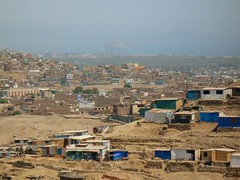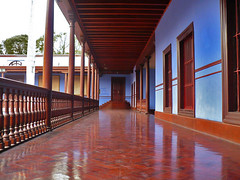Terror in the Middle and Upper Classes (& Bats in Miraflores)
It’s been something I wanted to write about for a while, but didn’t know how to approach it or even really what to say. It isn’t even a strictly Peruvian trait and I think it happens in much of the world where extreme inequality exists, such as the USA for example, where thanks to TV we see the middle and upper classes sealing themselves off from the wider world and living in fear of it. In Europe the rich and poor often live within walking distance (yes, people walk to places there), and this culture of fear is far less wide spread, in my opinion.
But I’m not in the USA or Europe, so I’ll stick to attempting to describe the Peruvian or even Limeño version of this phenomenon.
Perhaps if you have nice things you are right to fear loosing them. If you have your home, your health, a good income and a happy life – perhaps the thought of these things being taken away worries you. To have these things often takes a great deal of work – though all too often this work means avoiding your corruption being found out or exploiting people poorer than you with low wages. But the extremes to which this fear is taken can be frustrating.
Everyone is out to rob you, don’t leave your 4×4
Fear for personal safety is a big one here and it is a fear born out of worse times. Lima had a lot of trouble with terrorism at the end of the Shining Path insurgency and people died while going about their day. Lima also, around the same time, started filling up with hundreds of thousands of poor people migrating from the mountains for mostly the same reason, terrorism, but it was also the first major opportunity in which the indigenous people found they could move around their country at will, as for centuries before the white ruling elite prevented this. Lima was suddenly overwhelmed by poor desperate people building houses in the desert, and slightly less poor desperate people moving into the centre of the city. This arrival sent the upper classes running for cover to the greener areas in the south of the city as beggars and robbers began patrolling the streets trying to feed their families. The rich surround their homes with large walls and electric fences, and barricaded themselves in with metal bars on their windows.
Due to all the danger, parents drop their sons and daughters off at the houses of their friends, don’t let family members walk the streets at night, completely avoid central Lima whenever they can and often refuse to visit most of the country as tourists (it’s all too dirty and dangerous).
Ice cream will kill you
The belief is that if you eat ice cream, especially at night, you will have a bad throat the next day. You may even catch a cold or at worse flu. Little things like science don’t get in the way of this theory. The common cold is not a virus that can only infect you if you come into contact with it. It’s caused by ice cream, nothing more, well that or walking barefoot. Cold water or a cold soft drink is also a big no-no. Asking for ice in your drink will have people looking at you very strangely.
This is not just a Lima phenomenon, but it’s one of the places where people believe this the most, and one of the places where it is least true. If you happened to be living in the Andes in a mud hut in temperatures of -10c and you drank an iced tea, perhaps you’d have a problem – and this is most likely the origin of this myth. I wouldn’t be drinking cold drinks at night if I lived in the mountains either.
In Lima, high humidity and everything being absolutely filthy and unwashed (think taxis, combis and things in the street) means it may not be a good idea to lower your body temperature with a cold beverage as you might make your body more prone to being infected by a virus you come into contact with. However, you can eat as much ice cream as you like so long as you avoid dirty environments. My point is the fanaticism against cold things is just silly and misguided.
The middle classes spend hours emailing each other about the latest studies that proves this, that any anything gives you cancer or causes cholesterol, perhaps someone can create and forward around an email that explains the common cold is caused by a virus.
There are a lot of bad things in Lima; the city and the country can be dangerous in many ways. This is something I sometimes prefer to my bubble-wrapped vacuum sealed warning label country where a packet of nuts cries “WARNING: May contain traces of nuts”, and advice that an electric kettle may become hot if heated. Here, there are enough things to be generally and rightly concerned about. But some people are always searching for more. In Miraflores for example.
Lima is home to two species of bats, and always has been. The two species are one that eats insects and one that eats nectar. Yet due to the half a dozen or so deaths a thousand miles away in the jungle caused by bites from vampire bats, the residents of Miraflores are living in fear of their harmless neighbours and no amount of reason or facts will dissuade them from their fear. According to residents bats are running ramped in the parks of Miraflores after dark. Peru 21 says residents claim to have witnessed increased numbers in their parks.
“The amount of bats at night is simply uncountable. There are too many.
Residents are afraid of walking near the park”, explains security guard Carlos Garcia.
“The problem with bats is that you just never know if they are
aggressive or carrying some type of disease,” said resident Jorge
Cabrera who wrongly suggests that the bat population is much higher than normal because he has finally noticed they exist due to the jungle reports, and doesn’t understand these bats can’t and won’t attack humans.
I am not sure what to make of this general fear of everything, and I don’t suggest that any of it is unfounded, on the contrary. But it is in an interesting aspect of life here and thought I should mention even though I’m not sure entirely what to make of it.
I’d appreciate anyone’s views on the subject.
Tags: bats, crime, indigenous, lima, middle class, miraflores, shining path, terrorism










![The Andean Sistene Chapel in Andahuaylillas [Featured]](http://farm4.static.flickr.com/3240/2982277581_a1f1893c12_m.jpg)